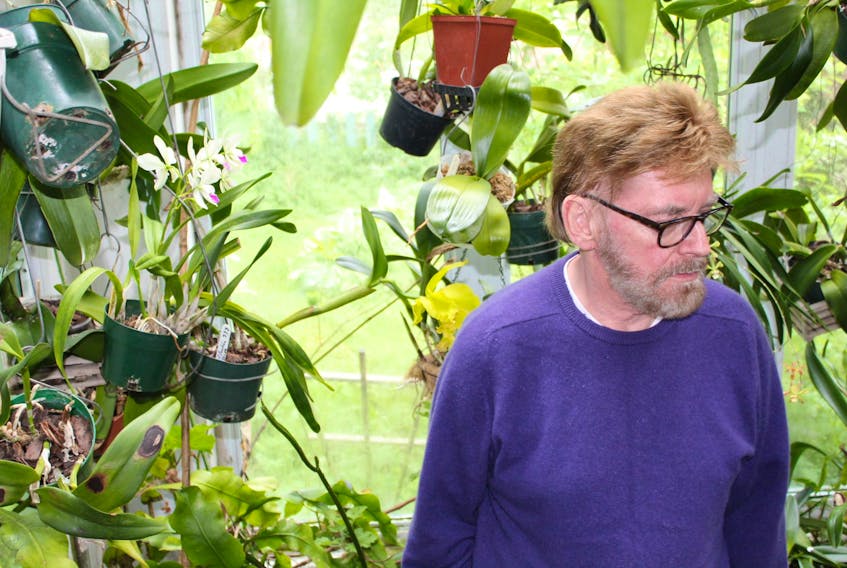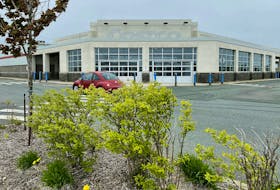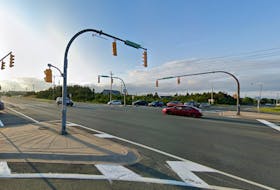ST. JOHN'S, N.L. — If you were looking for a place to be out in St. John’s in the 1970s, ‘80s, ‘90s into the ‘00s, there’s a good chance you danced or drank in one of Eric Clark’s bars.
And if you were straight in the 1980s, you’d be lined up on Water Street trying to get into hotspot Club Max.
Clark took a bold step with his longtime business and onetime life partner, Duncan Morris, to start the first openly gay bar to St. John’s. From then on, there were several of Clark’s bars — gay and dance clubs — that fostered tolerance.
“We might have saved lives. I am sure we did. You could be who you want to be,” Clark said during an interview with The Telegram in his St. John’s home.

“I’m proud of it. It wasn’t easy to do it at the time, to expose yourself as being gay at that time and have an openly gay business on Water Street.
“You had no gay marriage. You had no gay rights very much. (For the customers) it was their safe spot and they had support and acceptance and they could be themselves. If they wanted to wear a lampshade on their head they could do it. … We didn’t tolerate anybody being rude to ourselves or our customers.”
Clark was a saxophonist, a keyboardist, a flutist and a manager with the seven-piece rock band Garrison Hill, which included American serviceman Tony Gaines, who had been stationed at Argentia. Clark went to visit Gaines in New York City.
Around the era of the Stonewall riots — the advent of the gay rights movement that began with a protest over police raids at the Greenwich Village bar — it was a world away from what it was like to be a young gay man in St. John’s.
“I got to see another gay life compared to what it was here. It was very closeted (in St. John’s) and homophobia was under the surface. Being in a band and very social, I was sort of accepted. Took a while to realize though. … I dated girls and lived the rock star life with the band,” he recalled.
In New York, Clark’s eyes were opened to gay people on the streets and lots of venues, a scene that in the later 1970s included the iconic Studio 54, the legendarily opulent, over-the-top, celebrity- and indulgence-fuelled club.
“That was wild. … It was just like the movie,” Clark said of what it was like to visit Studio 54, the haunt of avant-garde artist Andy Warhol, the fashion crowd and the who’s who of society.
The sidewalks night after night were lined with people desperate to get in.
“Young and cute,” Clark said of how he managed to get through the door.
“It was the first time I saw people I could associate with who were similar to myself,” Clark said.
The New York experience inspired his involvement in the St. John’s bar scene and began with the live band/dance venue Outer Limit on Topsail Road.
While it was a straight bar, it was gay friendly, and the bar seemed to draw some ire, Clark said.

“The cops really harassed the place. … In those days city hall, the liquor commission and the fire department generally had a bad opinion of bars in general. But if there was anything involved with a sort of gay overtones, they were much rougher,“ he said.
Eventually, Clark said, he felt he had different goals than his business partners, a straight couple.
A new disco closer to downtown — Stanley’s Steamer — on Torbay Road drew away the clientele.
“It’s not unlike the Stavanger thing and Galway,” he said of the shifting trend.
The first official openly gay bar was Friends on Water Street.
It was the mid-1970s and the Bee Gees and Donna Summer were huge. The dance club paid close attention to the New York music scene and drew an eclectic clientele, both gay and straight.
“We wanted a place that we could enjoy ourselves and be out in the open. One thing that Friends did was it opened a lot of straight people’s eyes to accepting gay people. They came and they had a great time there,” Clark said.
“Friends had everybody going there, but it was a gay bar and they accepted they were on gay territory.”
It was upstairs from a biker bar, whose patrons, said Clark, protected his lesbian, gay and transgender (LGBT) clientele.
“It was really a strange association. I guess we were all sort of considered outcasts of some sort to some people,” Clark said.
Police would raid Friends more than most, he said.
“You had the feeling they had an attitude that gay people were not the same as straight people,” Clark said.
It was outside Clark’s later bar, Solomons, off Solomon’s Lane, where a gay man named Brian Nolan was kicked and arrested in July 1993. He was called faggot and queer, according to a police complaint commission decision. The adjudicator found the arrest was a result of unfounded assumptions, a failure to conduct proper inquiry, and a failure to pay any attention to clear evidence and a failure to understand the Detention of Intoxicated Persons Act.
Clark is still taken with Nolan’s resolve in standing up to the police.

“He is one of the brave people in the gay history situation with security and the cops,” said Clark.
But Clark said the St. John’s gay bars overall seemed to fare better than in other cities in Canada because of the connectivity of people here.
The bars gave LBGT customers a place to gather, but for many staff, it was a chance at a job when it was hard to get hired, Clark said.
A run-in with the fire department over overcrowding led to Friends being reduced to operating on the bottom of its two floors, and that was the end of it, he said.
“They just wanted to punish us. … Some people in higher places thought the bar shouldn’t be there, that there shouldn’t be a gay bar,” Clark said.
So Clark’s next venture with partners was Club Max — no expense was spared in the design of the art deco club, where the Luxus Boutique Hotel is now. They imported brilliantly coloured neon from New York, and had the furniture and bar custom made. There were fresh flowers on the bar every night. The club had a sweeping staircase, chandeliers, mirrors and bouncers dressed in tuxedoes.
It was the closest St. John’s was going to get to Studio 54, and the crowd — straight and gay — went mad for it.
“Not unlike Studio 54, people were on the list there, too,” Clark said. “Some people got in and some didn’t. With the doormen, it was whoever bribed them with money, and with us it was who we knew. … You had to have a new outfit to go down.”
The bar was named for Clark’s Scottie dog, Max.
It had a 10-foot video screen with Betamax videos shipped in from New York — Clark was the second person to sign on with the distributer.
And if you were a child of the 1980s, you know how big music videos were. They spawned the MTV and Much Music generation and inspired the song “Video Killed the Radio Star.”
The cash and the drinks flowed steadily.
And then the AIDs epidemic hit, with little early information about how it was contracted, some erroneously believing it could be passed through the air or by drinking from a glass someone else had touched.
The bar had some gay staff and so a lot of straight people turned away.
Clark also lost many friends to the disease, then a death sentence.
The party was over at Club Max as times changed and patrons began flocking to the emerging George Street scene, and the Corner Stone bar became the new rage.
It was heartbreaking to see Club Max dwindle away and Clark went on to buy back much of the equipment in an auction as he split with the investors who owned the building. He figures the elaborate staircase wound up in Robin Hood Bay.
“It’s the nature of bars,” he says now.
“They have a lifespan generally. … What can you do? It existed, no one can deny that.”
Clark particularly loved being a veejay at the clubs, and those duties are among his fondest memories. Another was some of the cast of the soap opera "Another World" frequenting Friends during an appearance in St. John’s.
“Your parents watched it. You'd come home and, ‘My story is on.’”
The worst for him, Clark said, was the end of Club Max and how his investors tried to go on without him and Morris.
“I never experienced that before. Friendship didn’t matter. Loyalty didn’t matter. It was just business,” he said.
The next bar was Private Eyes, which operated from 1987-91 on Water Street, and was his least favourite.
Then came Solomons, with its stain glass and brass railings.
The longest-serving gay bar was The Zone, which operated for 17 years — with celebrity patrons including Jann Arden and Green Day, as well as regular drag queens and organized LGBT events — before the lease was terminated as the owners sought another opportunity amid the oil boom, he said.
Clark thought about another bar, but leases were too expensive — typical rents were quoted at $10,000 a month. The Zone has been closed for about eight years.
“I was old enough then and had done enough. It was time to get out of it," he said.
With the internet and society’s relative comfort with LGBT-plus rights, it’s a tougher time for gay bars, he said. They aren’t as essential for people to be open about their sexuality and meet others from the community.
“Young people are on their phones all the time and hooking up on Twitter and all the other apps,” said Clark.
“They don’t need that support anymore. They are a click away from it.”
[email protected]
Twitter: @BarbSweetTweets
The importance of safe spaces
“I confirmed to myself I was bisexual in the ninth grade. At that age I still hadn't had much real-life experience. Exposure came mostly from reading fan fiction on the computer late at night. I knew I found both genders attractive, but as the years went on I would fall into a serial monogamy of heterosexual relationships. Even though I was passing as straight, many of my friends were not. I was never much of a partier, but when I did go out, The Zone brings back the fondest memories. I was so happy to be in a place we could coin "the gay bar" here in St. John’s. I would always meet such interesting and wonderful people. Fast forward and I am finally breaking away from my heteronormative cycle. My bisexual “ah ha!” moment is thanks to Velvet. I finally felt I was queer because of a night there. My then-girlfriend kissed me for the first time on the dance floor. I could hear the other dancers cheering. This is what safe spaces look like. This is what safe spaces feel like. Being able to kiss and not worry, even be applauded for it. I avoided telling this story because I was afraid it was a sad one. But it is a happy story that we were able to be in each other's lives, and she helped me on part of my queer journey. “
Jill Reid, St. John’s









